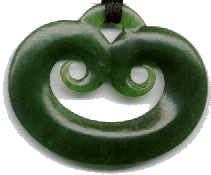General
> Pronunciation
Guide and Notes
> Introduction
to Grammar
> Description
of Designs Used
> Reo
Māori Sound Files
> Reo Māori Flash Cards
Any corrections or comments are welcome. Contact me.
Last updated 28
December 2000.
Site
History
Introduction to Te Reo Grammar
The first challenge for me as an English speaker learning Māori was that there is no word "is" (or "was") in Māori. I tended not to notice at first but as soon as I started to try and translate English to Māori, I noticed! What does "is" mean, anyway? Māori provides different sentence structures instead of using "to be".
The first, and most simple, structure I learned is a declarative sentence. In English, these statements always have an "is" in them. In Māori, they are called "ko" sentences because they always start with the word "ko". "Ko" cannot be translated back into English, but they can be thought of as a flag saying "this sentence is a declaration".
| Ko sentences | |
| Aoraki is the mountain | Ko Aoraki te maunga |
| You are the teacher | Ko koe te kaiako |
| You are the teacher | Ko te kaiako koe |
When people mihi (formally introduce themselves) in Māori, they often start with a series of "ko" sentences like this as they whakapapa (trace their ancestry) back to where they come from.
Also in mihi, you will hear "nō" sentences. The word "nō" can be translated as "from", "of" or "belonging to".
| Nō sentences | |
| I am from Christchurch | Nō Ōtautahi ahau |
It is simple and embarrasing to mix the "nō" and "ko" sentences up as I sometimes did when I was learning. "Ko Ōtautahi ahau" means "I am (called) Christchurch".
Also amongst the first things I learnt is that the noun does not change with plurals. Instead the article changes.
| Plurals | |
| The stick | Te rākau |
| The sticks | Ngārākau |
| My stick | Tāku rākau |
| My sticks | Āku rākau |
Location is described with "Kei" sentences.
| Kei sentences | |
| John is at the shops | Kei ngā toa Hone |
Action is often denoted by "Kei te" sentences.
| Action sentences | |
| I am sitting | Kei te noho au |
| I am sitting | E noho ana au |
The two forms are equivalent, although I think various tribes may have a preference toward one form or another.
The verb (kupu mahi) does not change when the tense changes.
| Tenses | ||
| I am running | Kei te oma au | (Present continuous) |
| I am running | E oma ana au | (Present continuous) |
| I will run | Ka oma au | (Future) |
| I ran | I oma au | (Past) |
| I have run | Kua oma au | (Past completed) |
In English, different forms of the verb "to run" were used (running, run, ran). In Māori the verb oma (to run) is unchanged.
The forms "ka" and "e.. ana" can also be used for any tense where that tense has already been introduced. This can be useful in story telling to allow more variety in sentence structure.
| Tenses | |
| Yesterday, I walked to the shop. | Inanahi, ka hikoi ahau ki te toa. |
| I will walk to the shop, tomorrow. | E hikoi ana au ki te toa, apopo. |
This is a very quick introduction for some of the concepts I have learned of Maaori grammar.
| Vocab Used on this Page | |
| Ahau | I, me |
| Āku | My (a-category, plural) |
| Apopo | Tomorrow |
| Au | I, me |
| Hikoi | To walk |
| Hone | John (transliteration) |
| Inanahi | Yesterday |
| Ki | To |
| Maunga | Mountain |
| Ngā | The (plural) |
| Noho | To sit |
| Oma | To run |
| Ōtautahi | Christchurch |
| Tāku | My (a-category, singular) |
| Te | The (singular) |
| Toa | Shop |
![]()
Pronunciation Guide and Notes | Reo Maaori Sound File Collection
Copyright © 1999, 2000 Gavin Kingsley. Contact me.
